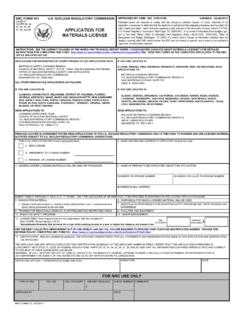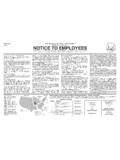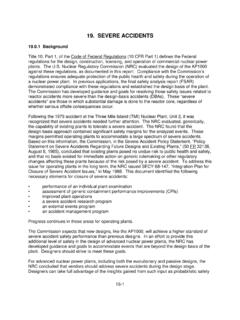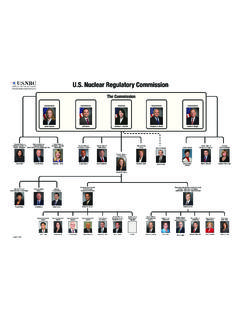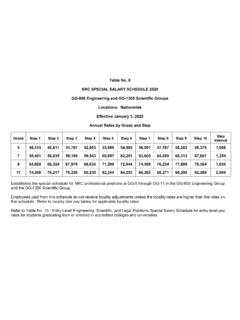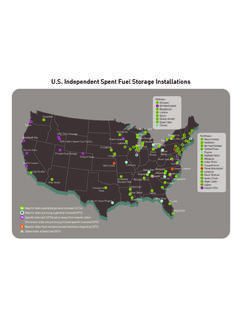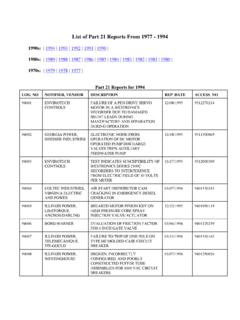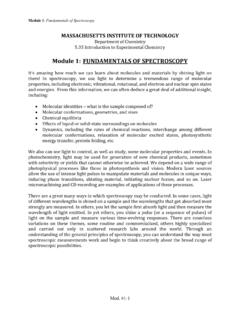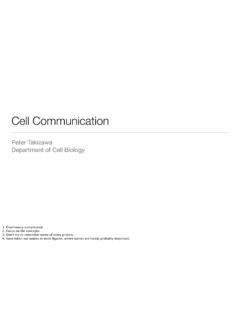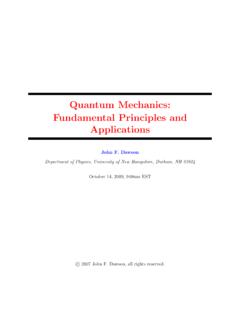Transcription of Safety Culture Trait Talk - Nuclear Regulatory Commission
1 Safety CULTUREE ffective Safety Communication Trait TALKT rait Talk was developed to provide you with a better understanding of the nine Safety Culture traits found in the Nuclear Regulatory Commission s (NRC) Safety Culture Policy Statement (SCPS) and how they apply to you whether you are an NRC licensee, a vendor or contractor employee, an organization interested in the safe and secure use of Nuclear materials, or others involved in Nuclear Safety regulation. Please see page 4 of Safety Culture Trait Talk for more information on the has shown that certain personal and organizational traits are present in a positive Safety Culture . A Trait , in this case, is a pattern of thinking, feeling, and behaving that emphasizes Safety , particularly in goal conflict situations, for example, in situations where production, schedule, or just the cost of effort may conflict with doing the job safely.
2 The NRC identified nine traits of a positive Safety Culture in the SCPS, although the agency recognizes that additional traits may also be important. In addition, please note that the traits were not developed to be used for inspection Trait Talk includes a fictional scenario based on a different licensee or community. The scenario used in this Trait Talk is based on the fuel cycles community. As you read through Trait Talk, consider the following questions: 1. How does this Trait apply to my organization? 2. Are there other attributes and examples that better fit my organization? 3. What impact does this Trait have on the Safety Culture in my organization? 4. How does this increase my understanding of the Safety Culture in my organization? 5. How could I improve the performance of this Trait in my organization?What Is The Definition Of Effective Safety Communication?
3 The NRC s SCPS defines Effective Safety Communication as communications that maintain a focus on Is This Trait Important?Effective Safety communication is vital to maintaining a Safety Culture . When employees regularly communicate with each other in an open, respectful manner, they are also more willing to give and receive feedback. Effective communication also supports teamwork and coordination between groups. Employees learn about, and become part of, an organization s Safety Culture through communication. Lack of clear communication from management can result in situations where managers say one thing but do another. Employees then spend time and energy trying to interpret the conflicting messages. In such situations, employees will generally interpret a manager s behavior as the more valid indicator of the organization s values and priorities.
4 Persistent mismatches between formal and informal communications can lead employees to disregard or develop a cynical view of formal communications. This can lead to ineffective formal communications from management and a weakened Safety Culture . Top-down communication is most effective when senior managers communicate directly with immediate supervisors and immediate supervisors communicate with their staff. Ensuring that supervisors are informed about organizational issues, and then allowing them to communicate these issues to their staff, helps create and reinforce the supervisor s power. Research shows that when employees perceive their supervisor as having power, employees have greater trust in their supervisor, greater desire to communicate with their supervisor, and are more likely to believe the information coming from their supervisor.
5 Upward communication from workers to managers, and information exchange among workers, is essential for organizational learning and safe operations. An employee s perceptions about support for Safety can strongly influence his or her willingness to speak up. Some common barriers to upward communication include fear of retaliation, concerns that the communication will be filtered as it goes up the chain of command, perceptions that management is resistant to critical feedback, and fear of creating interpersonal conflict. These communication barriers, if unaddressed, can have a negative impact on information exchange, organizational learning, and ultimately safe performance. To facilitate effective upward communication, it is important for managers to create an environment that is supportive, encouraging, and accepting of both positive and negative feedback, so employees always feel free to speak 6 December, 2014 One of the traits of a positive Safety Culture as described in the Nuclear Regulatory Commission s Safety Culture Policy Culture Trait TALKWHAT DOES THIS Trait LOOK LIKE?
6 Work Process Communications: Individuals incorporate Safety communications in work activities. Communications within work groups are timely, frequent, and accurate. Work groups and supervisors communicate with other work groups and supervisors during the performance of their work activities. Individuals communicate with each other such that everyone has the information necessary to accomplish work activities safely and effectively. Communications during shift turnovers and pre-job briefings provide information necessary to support Nuclear Safety . Work groups integrate Nuclear Safety messages into daily activities and meetings. Bases for Decisions: Leaders ensure that the bases for operational and organizational decisions are communicated in a timely manner. Leaders promptly communicate expected outcomes, potential problems, planned contingencies, and abort criteria for important decisions.
7 Leaders share information on a wide range of issues with individuals and periodically verify their understanding of the information. Leaders take steps to avoid unintended or conflicting messages that may be conveyed by decisions. Leaders encourage individuals to ask questions if they do not understand the basis of a management decision. Executives and senior managers communicate the reasons for resource allocation decisions, organizational changes, and other decisions affecting the organization as a whole, including the Safety implications of those decisions. Free Flow of Information: Individuals communicate openly and candidly, both up, down, and across the organization and with oversight, audit, and Regulatory organizations. Leaders encourage the free flow of information. Individuals share information openly and candidly. Leaders respond to individuals in an open, honest, and non-defensive manner.
8 Individuals provide complete, accurate, and forthright information to oversight, audit, and Regulatory organizations. Leaders actively solicit feedback, listen to concerns, and communicate openly with all individuals. Leaders candidly communicate the results of monitoring and assessments throughout the organization and with independent oversight organizations. Expectations: Leaders frequently communicate and reinforce the expectation that Nuclear Safety is the organization s overriding priority. Executives and senior managers communicate expectations regarding Nuclear Safety so that individuals understand that Safety is the highest priority. Executives and senior managers implement a strategy of frequent communication using a variety of tools to reinforce that Nuclear Safety is the overriding priority. Executives and senior managers reinforce the importance of Nuclear Safety by clearly communicating its relationship to strategic issues, including budget, workforce planning, equipment reliability, and business plans.
9 Leaders communicate desired Safety behaviors to individuals, providing examples of how behaviors positively or negatively affect Nuclear Safety . Leaders routinely verify that communications on the importance of Nuclear Safety have been heard and understood. Leaders ensure supplemental personnel understand expected behaviors and actions necessary to maintain Nuclear United States Nuclear Regulatory CommissionSAFETY Culture Trait TALKWHAT IS A SCENARIO IN WHICH THIS Trait COULD PLAY A ROLE? Fuel fabrication facilities monitor many of the processes of plant operations that use special Nuclear material from the control room. This monitoring allows qualified operators to identify process deviations or system problems when processes are not working as intended or there are equipment malfunctions. During one shift, an operator noticed a slight decrease in the solution level inside the extraction column of the uranium recovery process.
10 The operator was not properly trained for recognizing the possible scenarios and the required actions for seeing such level fluctuation in the panel. The operator sent an employee for a visual check of the extraction system equipment. That employee found a small amount of liquid on the floor near the extraction column level control valve and assumed it was a leaking valve stem near the control valve. The employee communicated to the control room that everything was okay. During the next shift, a second operator continued to see a level deviation in the monitor of the extraction column process area and notified his supervisor. The supervisor immediately inspected the system components and identified a leak in the extraction column piping which resulted in a spill of high-enriched uranium solution with the potential of causing an inadvertent criticality accident.
